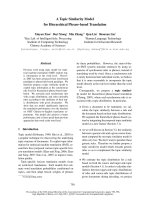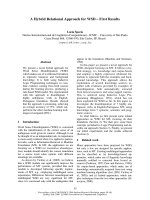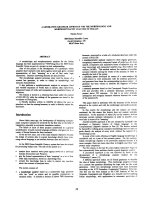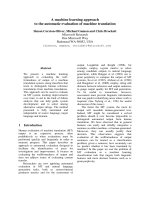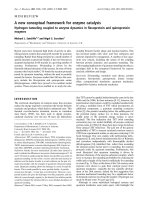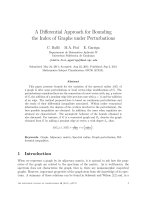Báo cáo y học: "A Protein Similarity Approach For Detecting Prophage Regions In Bacterial Genomes" potx
Bạn đang xem bản rút gọn của tài liệu. Xem và tải ngay bản đầy đủ của tài liệu tại đây (472.35 KB, 20 trang )
Genome Biology 2005, 6:P11
Deposited research article
A Protein Similarity Approach For Detecting Prophage Regions
In Bacterial Genomes
Geeta V Rao, Preeti Mehta, Srividhya KV and Krishnaswamy S
1§
Address:
1
Bioinformatics Center, School of Biotechnology, Madurai Kamaraj University, Madurai - 625021, India.
Correspondence:
§
S Krishnaswamy. Email:
comment
reviews
reports
deposited research
interactions
information
refereed research
.deposited research
AS A SERVICE TO THE RESEARCH COMMUNITY, GENOME BIOLOGY PROVIDES A 'PREPRINT' DEPOSITORY
TO WHICH ANY ORIGINAL RESEARCH CAN BE SUBMITTED AND WHICH ALL INDIVIDUALS CAN ACCESS
FREE OF CHARGE. ANY ARTICLE CAN BE SUBMITTED BY AUTHORS, WHO HAVE SOLE RESPONSIBILITY FOR
THE ARTICLE'S CONTENT. THE ONLY SCREENING IS TO ENSURE RELEVANCE OF THE PREPRINT TO
GENOME BIOLOGY'S SCOPE AND TO AVOID ABUSIVE, LIBELLOUS OR INDECENT ARTICLES. ARTICLES IN THIS SECTION OF
THE JOURNAL HAVE NOT BEEN PEER-REVIEWED. EACH PREPRINT HAS A PERMANENT URL, BY WHICH IT CAN BE CITED.
RESEARCH SUBMITTED TO THE PREPRINT DEPOSITORY MAY BE SIMULTANEOUSLY OR SUBSEQUENTLY SUBMITTED TO
GENOME BIOLOGY OR ANY OTHER PUBLICATION FOR PEER REVIEW; THE ONLY REQUIREMENT IS AN EXPLICIT CITATION
OF, AND LINK TO, THE PREPRINT IN ANY VERSION OF THE ARTICLE THAT IS EVENTUALLY PUBLISHED. IF POSSIBLE, GENOME
BIOLOGY WILL PROVIDE A RECIPROCAL LINK FROM THE PREPRINT TO THE PUBLISHED ARTICLE.
Posted: 9 September 2005
Genome Biology 2005, 6:P11
The electronic version of this article is the complete one and can be
found online at />© 2005 BioMed Central Ltd
Received: 7 September 2005
This is the first version of this article to be made available publicly.
This information has not been peer-reviewed. Responsibility for the findings rests solely with the author(s).
A Protein Similarity Approach For Detecting Prophage
Regions In Bacterial Genomes
Geeta V Rao, Preeti Mehta, Srividhya KV and Krishnaswamy S
1§
1
Bioinformatics Center, School of Biotechnology, Madurai Kamaraj University,
Madurai - 625021
§
Corresponding author
Email addresses:
GVR:
PM:
KVS:
SK:
Abstract
Background
Numerous completely sequenced bacterial genomes harbor prophage elements. These
elements have been implicated in increasing the virulence of the host and in phage
immunity. The e14 element is a defective lambdoid prophage element present at 25
min in the Escherichia coli K-12 genome. e14 is a well-characterized prophage
element and has been subjected to in-depth bioinformatic analysis.
Results
A protein-based comparative approach using BLAST helped identify lambdoid-like
prophage elements in a representative set of completely sequenced bacterial genomes.
Twelve putative prophage regions were identified in six different bacterial genomes.
Examination of the known and newly identified prophage regions suggests that on an
average, the prophage elements do not seem to occur either randomly or in a uniform
manner along the genome amongst genomes of the selected pathogenic organisms.
Conclusion
The protein based comparative approach can be effectively used to detect lambdoid-
like prophage elements in bacterial genomes. It is possible that this method can be
extended to all prophage elements and can be made automated.
Background
Bacterial genome nucleotide sequences are being completed at a rapid and increasing
rate, thanks to faster and better sequencing techniques. Many completely sequenced
bacterial genomes harbor temperate bacteriophages, both functional and defective.
The gene products encoded by prophages can have very important effects on the host
bacterium, ranging from protection against further phage infection to increasing the
virulence of a pathogenic host. Numerous virulence factors from bacterial pathogens
are phage encoded [1,2,3] for example, the food poisoning botulinus toxin and Vibrio
cholerae. The latter is a fascinating case of how multiple phages contribute to
bacterial pathogenicity. It is postulated that some adaptations of nonpathogenic
bacterial strains to their ecological niche might also be mediated by prophage
genomes [4]. As mobile DNA elements, phage DNA is a vector for lateral gene
transfer between bacteria [5]. As reviewed by Canchaya et al [6] technically
difficulty relies in defining prophage sequences in bacterial genomes as mostly they
are cryptic or in the state of mutational decay.
Prophages account for a substantial amount of interstrain genetic variability in several
bacterial species, for example Staphylococcus aureus [7] and Streptococcus pyogenes
[8]. When genomes from closely related bacteria were compared in a dot-plot
analysis, prophage sequences accounted for a major proportion of the differences
between the genomes , for example, Listeria monocytogenes and Listeria innocua [9]
and Escherichia coli O157 and K-12 [10]. When mRNA expression patterns were
studied using microarrays in lysogenic bacteria that underwent physiologically
relevant changes in growth conditions, prophage genes figured prominently in the
mRNA species changing their expression pattern [11,12]. These data demonstrate that
prophages are not a passive genetic cargo of the bacterial chromosome, but are active
participants in cell physiology. The medical and evolutionary importance of
prophages makes it important that one is able to recognize and understand prophages
when they are present.
Recognizing prophages in bacterial genome sequences is not a straightforward task.
Even if the search for prophage elements is restricted to tailed temperate phages (there
are other kinds of temperate DNA phages [13,14]) none of the phage genes are
sufficiently conserved to serve as a single marker for prophages, and in any given
case, any particular gene could have been deleted from a defective prophage [15,16].
Therefore, using a single gene like integrase or terminase might not be complete for
prophage identification. Some prophages have different G+C contents,
oligonucleotide frequencies or codon usage from their host genome, but this type of
analysis has not progressed to the point that it can unequivocally identify prophage
sequences [17]. One must therefore identify prophages in bacterial genome sequences
by the similarity of their gene sequences and gene organization to known prophage
genes.
E. coli and other enterobacterial genomes are recognized to contain a number of
lambda-like cryptic prophages. For example, the very well characterized E. coli K-12
genome carries eight convincingly identified prophages and six of these, DLP-12,
e14, Rac, QIN, CPS-53, and Eut are lambdoid in nature. A comprehensive
bioinformatic analysis has been carried out on the e14 sequence [18]. This analysis
showed the modular nature of the e14 element, and that it shares a large part of its
sequence with the Shigella flexneri phage SfV. Based on this similarity, the regulatory
region including the repressor and Cro proteins and their binding sites were identified.
The e14 element is 15.4 kbp long and lies between 1195432 bp and 1210646 bp on
the K-12 chromosome. The element uses a homologous region of 216 bases in the icd
gene as the integration site, though the actual crossover for integration occurs within
the first 11 bases at one end of the homology [19]. The integration event caused only
two amino acid changes in the isocitrate dehydrogenase protein. The element is
capable of excision if the SOS response is triggered. Both excision and re-integration
occur in a site-specific manner [20,21]. The e14 element was mapped on the E. coli
K12 chromosome and cloned by van de Putte et al [22]. The element is known to
encode several important functions including the lit gene involved in T4 exclusion
[23,24], the rglA (mcrA) gene involved in restriction of hydroxymethylated
nonglucosylated T4 phages [25,26] and the pin gene involved in inversion of an
adjacent 1800-basepair segment [22,27]. The element also encodes a Kil function and
the concomitant repressor protein [28] and an SOS induced cell division inhibition
function attributed to the sfiC gene [29].
A protein based COG approach helped detect lambdoid-like prophage elements in a
set of eight completely sequenced bacterial genomes [18]. This approach is different
from the other approaches in that it does not rely on a single gene like integrase or
terminase for prophage detection, but has the potential to use the entire known pool of
temperate tailed phage-encoded genes for detection against the COG data [30]. Such
a comparative protein level approach can be effectively used to detect defective
lambdoid-like prophage elements in bacterial genomes.
Results and Discussion
The e14 element is a very well characterized prophage element [18], which contains
all the highly conserved prophage genes like the phage portal and terminase genes.
This analysis [18] also involved a protein based COG approach for identifying similar
prophages. This takes into consideration the modular nature of prophage genomes and
looks for homologs of the genes of the prophage e14 that exist in proximity to each
other. The same idea was utilized in this study. The choice of e14 proteins as
template for similarity searches for prophage elements was retained as in the earlier
analysis. However the search procedure (BLAST instead of COG) was modified in
view of possible automation and flexibility. A larger set of genomes from 40
pathogenic organisms were scanned in this analysis.
Identifying prophage elements in bacterial genomes
A set of forty bacterial genomes was chosen for prophage detection, and only the ones
that yielded significant BLAST hits (e < = 0.01) are listed in Tables 1 and 2. The
BLAST searches were carried out organism-wise and then the hits were sorted based
on the locus of occurrence in the genome. Lone hits were analyzed to check whether
they form part of prophages reported in literature, and if so, they are included in
Table 1.
Genes encoding the BLAST hits for the different e14 proteins, which were within a
particular distance (this distance varies from one organism to another; it is the size of
the longest prophage in the organism’s genome) were then clubbed together. Any
region with two or more genes in this cluster were considered as putative prophage
elements and further analyzed. Most of these clusters belong to pre-annotated
prophage elements, but twelve putative prophage elements were identified in six
organisms- S.flexneri 2457T, S. enterica LT2 (serovar Typhimurium), S. pyogenes
M18 MGAS8232, S. pyogenes M3 MGAS315, Vibrio cholerae N16961 and P.
luminescens subsp. laumondiiTTO1. For the former, prophage regions were delimited
using data from the prophage database [31] and from literature [32]. As for the
putative prophage regions, the prophage limits are reported from the first hit to the
last hit in each cluster (data taken from .ptt files from
Prophage loci given in parentheses represent possible outer limits for the prophage
regions (Table 2). The genes forming part of these outer limits were not picked up in
the similarity searches, but are reported here because they are prophage-related
proteins or have strong similarity to prophage proteins.
Of the twelve putative prophage regions identified, five are located near
dehydrogenase genes (Table 3). A priori there seems to be no attributable reason to
this tendency for the putative lambdoid phages to get integrated near a dehydrogenase
gene in the bacterial genome. However, it must be noted that the search template e14
is also integrated at the isocitrate dehydrogenase gene in the E. coli K12 genome.
Prophage distribution
In order to address the question whether the prophage elements integrate in a random
and isotropic manner into bacterial genomes, these genomes were brought into a
common reference frame to facilitate comparison. All genome lengths were
normalized to 1000 units and prophage coordinates (both known and newly identified
ones) were re-calculated in terms of these normalized units. The distribution of
prophage elements (Figure 1) is found to be uni-modal with a maximum frequency of
occurrence in the range of 400-600 genome units. On an average, the prophage
elements do not seem to occur either in a random or in a uniform manner along the
genome amongst genomes of the selected pathogenic organisms.
Conclusion
We could identify several lambdoid prophage elements in a representative set of
bacterial genomes using a protein similarity approach. It has been observed that
lambdoid phages have a strong tendency to get integrated near a dehydrogenase gene
in the bacterial genome. A prophage distribution study shows that most of the
prophages are found in comparable regions in the bacterial genomes. This exercise
was knowingly limited by only taking genes similar to that of e14 into consideration.
A similar approach using the entire pool of known lambdoid prophage (or even all
temperate prophage) genes with appropriate weighting for the frequency of
occurrence of the prophage proteins, should make a much more sensitive and robust
technique for detecting prophage elements.
Materials and Methods
The local version of the WWW-BLAST [33,34] was installed and used for sequence
analysis. In order to identify e14 homologs, similarity searches at the protein level
were done taking the twenty-three e14 proteins as query and the bacterial proteomes
as target. The bacterial proteomes were downloaded from NCBI’s FTP site
( Similarity searches were done using BLASTP with
default values. Only the significant hits (e < = 0.01) were used for the analysis.
Figures
Figure 1
Figure Legends.
Figure 1
Comparative prophage distribution across genomes
All genome lengths were normalized to 1000 units and prophage loci for both known
and newly identified ones were calculated in terms of these normalized units. The
graph was drawn taking normalized genome distance along X-axis and the number of
prophages along Y-axis.
Table 1: Prophage elements identified but already known. Prophage elements
detected in other genomes using similarity to e14 proteins as a criterion. BLAST hits
for the e14 proteins in different organisms were examined, and only the significant
hits (e < = 0.01) are listed. The boundaries of the prophage elements as reported
[31,32] are provided. Entries marked * are based on Mehta et al [18].
Organism Proteins in e14
element
Related genes
identified
Locus as reported
[30,31]
Prophage
name
B. subtilis *
b1152 Bsu1274 1316849-1347491 PBSX
b1152, b1158 Bsu2593,
Bsu2572
2652219-2700977 SKIN
B. melitensis M
b1151 BMET1349 1394344-1404607 Bruc1
B. suis
b1151 BR0586 578083-584877 Brs1
C. tetani E88
b1140, b1158 CTC01567,
CTC01557
1663821-1696302 Cpt2
b1149, b1151,
b1152
CTC02132,
CTC02131,
CTC02115,
CTC02134
2242455-2281387 Cpt3
E. coli K12*
b1156, b1158
b0561, b0544 564025-585326 DLP12
b1156, b1157,
b1158
b1546, b1547,
b1545
1630450-1646830 QIN
b1156, b1157,
b1158
b1373, b1372,
b1374
1409966-1433025 Rac
b1154, b1156 b2353, b2355 2464404-2474619 KpLE1
E. coli
b1140, b1145 c1519, c1546 1397370-1452231 CP073-4
b1140, b1145,
b1155
c1400, c1410,
c1475
1327053-1372820 CP073-2
b1142, b1145,
b1147, b1149,
b1158
c3200, c3197,
c3195, c3192,
c3146
3019963-3065315 CP073-5
b1155 c0969 909332-942273 CP073-1
B1155 c0649 627155-630053 CP073-6
E. coli O157
VT-2 Sakai
b1140, b1141,
b1155, b1156,
b1157
ECs1609,
ECs1610,
ECs1651,
ECs1650
1618153-1665049 Sp8
b1140, b1140,
b1141, b1149
ECs1757,
ECs1813,
ECs1758,
ECs1792
1757506-1815680 Sp9
b1140, b1149 ECs1501,
ECs1542
1541470-1589892 Sp6
b1140 ECs1055 1161091-1210740 Sp4
b1140 ECs2773 2668007-2712035 Sp14
b1141 ECs0801 891123-929708 Sp3
b1145 ECs2990 2895926-2943804 Sp15
b1145, b1154,
b1155, b1155,
b1156, b1156,
b1157, b1157,
b1158
ECs0274,
ECs0280,
ECs0282,
ECs0281,
ECs0281,
ECs0282,
ECs0280,
ECs0283,
ECs0284
300041-310626 Sp1
b1145 ECs1185 1246012-1308719 Sp5
b1145, b1149,
b1149
ECs2279,
ECs2276,
ECs2251
2203952-2250093 Sp12
b1145 ECs2209 2158174-2203951 Sp11
b1149 ECs1598,
ECs1592
1594570-1610032 Sp7
b1149 ECs1971 1921414-1972525 Sp10
b1152, b1153,
b1158
ECs4987,
ECs4988,
ECs4992
5040843-5079601 Sp18
b1158 ECs3240 3192983-3201533 Sp16
b1158 ECs3516 3475965-3500163 Sp17
E. coli
b1149, b1151,
b1140
z1359, z1362,
z1323
1250521–1295458 CP-933M
b1149, b1151,
b1140
z1803, z1806,
z1764
1626722-1673485 CP-933N
b1149, b1149,
b1151, b1145
z6045, z6070,
z6042, z6073
2285976-2329446 CP-933P
b1145, b1154,
b1155, b1157,
b1158
z0309, z0314,
z0315, z0317,
z0318
300070-310251 CP-933H
b1140, b1141,
b1155, b1157
z1866, z1867,
z1920, z1918
1702185–1756006 CP-933X
b1140, b1155 z2966, z2983 2668339-2688870 CP-933T
b1149, b1151 z1854, z1849 1678706-1693737 CP-933C
b1140 z3130 2743223-2788348 CP-933U
b1140, b1145 z2036, z2090 1849488-1930250 CP-933O
b1145, b1149 z3358, z3332 2966382-3015014 CP-933V
H.
influenzaeRd
KW20
b1152, b1153 HI1520,
HI1521
1559962-1594275 FluMu
M. loti
MAFF303099
*
b1149, b1151 Mlr8521,
Mlr8522
6975633-7011594 Meso2
M.
tuberculosis
CDC1551
b1158 MT3573 3870821-3879383 Mt2
M.
tuberculosis
b1158 Rv1586c 1780641-1788503 Rv1
N.
meningitidisZ
2491 *
b1152, b1153,
b1157
NMA1323,
NMA1324,
NMA1325
1207416-1236260 Pnm2
b1152, b1153 NMA1826,
NMA1825
1768546-1807515 Pnm1
N.
meningitidis
MC58
b1153, b1155,
b1157
NMB1114,
NMB1119,
NMB1115
1099901-1133957 NeisMu1
S. aureus
N315
b1149
SA1777 2005924-2049520
φN315
S. aureus
MW2
b1149, b1152,
b1159
MW1401,
MW1392,
MW1403
1529381-1573005
φSa2mw
b1149 MW1908 2046605-2088749
φSa3mw
S. aureus
b1149, b1145 SAV1966,
SAV1998
2083583-2126179
φMu50B
S. enterica
(serovar Typhi
Ty2)
b1155, b1156,
b1157, b1158
t3435, t3434,
t3434, t3435,
t3433, t3437
3501128-3538076 Stt4
b1155, b1156,
b1157, b1158
t1349, t1349,
t1351, t1346
1314607-1441766 Stt1
b1155, b1156 t1867, t1867 1928058-1972330 Stt2
b1158 t2667 2735202-2754628 Stt3
S. enterica
CT18
(serovar
Typhi)
b1140, b1141,
b1143, b1144,
b1155, b1156
STY2077,
STY2076,
STY2069,
STY2068,
STY2013,
STY2013
1889471-1933558 Sti4b
b1155, b1155,
b1156, b1156,
b1157, b1158
STY3693,
STY3692,
STY3692,
STY3693,
STY3691,
STY3695
3515470-3548975 Sti8
b1155, b1156,
b1157, b1158
STY1639,
STY1639,
STY1638,
STY1637,
STY1640,
STY1641,
STY1642,
STY1643
1538899-1572919 Sti3
b1155, b1156,
b1158
STY1073,
STY1073,
STY1075
1008747-1052755 Sti1
b1158 STY2889 2760475-2768771 Sti7
S. enterica
LT2 (serovar
Typhimurium)
b1145, b1156,
b1157
STM0898,
STM0927,
STM0926
962612-1006517 Fels-1
b1154, b1155 STM2235,
STM2233
2330961-2345217 Stm6
b1155, b1158 STM2704,
STM2705,
STM2702
2844427-2879233 Fels-2
b1156, b1157 STM2586,
STM2588
2728976-2776816 Gifsy-1
b1156, b1157 STM1050,
STM1049
1098228-1143714 Gifsy-2
b1140, b1144 S0941, S0921 897790-930670 T5
b1140, b1155,
b1156
S2146, S2118,
S2118
2021895-2044342 T11
b1149, b1151 S1228, S1223 1177837-1191596 T7
b1154 S0319 313843-327223 T2
b1155, b1156 S2329, S2329 2208707-2214367 T12
b1158 S2781 692891-709118 T3
S. flexneri
2a301
b1140, b1159 SF2044,
SF2041
2049694-2066397 Flex9
b1149, b1151 SF1146,
SF1140
1175319-1188408 Flex5
b1154, b1155 SF0311,
SF0310
311291-328079 Flex2
S. pyogenes
b1140 SPy1488 1192854-1222549 370.2
b1157, b1158 SPy0671,
SPy0655
527569-571887 370.1
S. pyogenes
b1145 SpyM18_1306 1041280-1087739
φ
s
p
eL/M
b1145
SpyM18_1504 1206360-1241416
φ370.3-
like
b1149, b1158 SpyM18_0751,
SpyM18_0716
578093-618765
φspeC
b1149 SpyM18_0369 293882-332714
φspeA
S.
b1145 SpyM3_1143 1137743-1171867
φ
315.3
b1149 SpyM3_0946 977738-1018193
φ
315.2
b1149 SpyM3_0710 749213-788176
φ315.1
X. fastidiosa
9a5c*
b1140, b1149 XF1642,
XF1645
1585980-1631056 XfP4
Y. pestis KIM
b1145, b1152,
b1153, b1154,
b1157
Y2954, Y2937,
Y2935, Y2936,
Y2935, Y2934
3237524-3255252 Yers3
b1155, b1156 Y2185, Y2185 2417129-2456467 Yers1
Y. pestis CO92
b1145, b1152,
b1153, b1154,
b1157
YP01233,
YP01250,
YP01251,
YP01250a,
YP01252,
YP01252
1392489-1416524 YP3
b1155, b1156 YP02134,
YP02134
2364324-2413098 YP5
Table 2: Putative prophage elements newly identified in six organisms. Prophage
elements that were newly identified in the selected genomes using similarity to e14
proteins as a criterion. BLAST hits for the e14 proteins in different organisms were
examined, and only the significant hits (e < = 0.01) are listed. Estimates of the
prophage region are provided with the outer limits given in parentheses.
Organism Proteins in
e14 element
Related
genes
Prophage
region (outer
limit)
Location
(outer limit)
Prop
hage
nam
e
S. enterica
LT2 (serovar
Typhimurium
)
b1140,
b1158,
b1156, b1140
STM1861,
STM1865,
STM1868,
STM1871
STM1861–
STM1871
(STM1860–
STM1882)
1957835-
1967922
(1956854-
1975533)
St1
S. flexneri T
b1158, b1140 S2707,
S2723
S2707 –
S2723
(S2705 –
S2723)
2602155-
2613694
(2600230-
2613694)
Sf1
S. pyogenes
M18
MGAS8232
b1146,
b1151, b1159
SpyM18_0
636,
SpyM18_0
620,
SpyM18_0
615
spyM18_0615
-
spyM18_0636
(spyM18_060
9-
spyM18_0640
)
495793-506387
(492411-
511356)
Sp1
S. pyogenes
M3
MGAS315
b1146, b1159 SpyM3_03
99,
SpyM3_03
92
SpyM3_0392 -
SpyM3_0399
(SpyM3_0386
-
SpyM3_0403)
434301-439876
(430946-
444845)
Spy1
V. cholerae
N16961
b1159, b1159 VCA0307,
VCA0309
VCA0307-
VCA0309
(VCA0281-
VCA0324)
319123-322036
(300467-
328558)
Vc1
P.
luminescens
subsp.
laumondiiTTO
1
b1155,
b1156,
b1157,
b1157,
b1158,
b1155,
b1156, b1157
plu0018,
plu0019,
plu0021,
plu0020,
plu0029,
plu0033,
plu0033,
plu0034
plu0018-
plu0034
(plu0008-
plu0034)
17678-29999
(10251-29999)
Pl1
b1140,
b1155,
b1155,
b1155,
b1155,
b1156,
b1156, b1157
plu2947,
plu2956,
plu2958,
plu2961,
plu2873,
plu2873,
plu2961,
plu2784
plu2873-
plu2961
(plu2870-
plu2961)
3409531-
3466582
(3405940-
3466582)
Pl2
b1158,
b1155,
b1156, b1157
plu3296,
plu3332,
plu3327,
plu3326
plu3s296-
plu3332
(plu3296-
plu3338)
3912405-
3962420
(3912405-
3966510)
Pl3
b1155,
b1155,
b1155,
b1156,
b1156, b1157
plu3023,
plu3012,
plu3024,
plu3024,
plu3012,
plu3013
plu3012-
plu3024
3512834-
3525239
Pl4
b1146,
b1149,
b1156, b1157
plu3476,
plu3473,
plu3497,
plu3421,
plu3498
plu3421-
plu3498
4037155-
4092707
Pl5
b1157, b1157 plu1460,
plu1463
plu1460-
plu1463
1753139-
1756507
Pl6
b1155,
b1156,
b1156,
b1157,
b1157, b1157
plu2035,
plu2035,
plu2023,
plu2024,
plu2022,
plu2034
plu2022-
plu2035
2390996-
2405104
Pl7
Table 3: Prophages found near a dehydrogenase gene.
Organism Prophage
region (outer
limit)
Location
(outer limit)
Dehydrogenase gene
S. flexneri T
S2707 – S2723
(S2705–
S2723)
2602155-
2613694
(2600230-
2613694)
S2726 : IMP
dehydrogenase
S. enterica LT2
(serovar
Typhimurium)
STM1861–
STM1871
(STM1860–
STM1882)
1957835-
1967922
(1956854-
1975533)
STM1886: glucose-6-
phosphate dehydrogenase
S. pyogenes M18
MGAS8232
spyM18_0615
-
spyM18_0636
(spyM18_0609
-
spyM18_0640)
495793-
506387
(492411-
511356)
spyM18_0608: Putative
nucleotide sugar
dehydrogenase
S. pyogenesM3
MGAS315
SpyM3_0392 -
SpyM3_0399
(SpyM3_0386
-
SpyM3_0403)
434301-
439876
(430946-
444845)
SpyM3_0385:Putative
nucleotide sugar
dehydrogenase
P. luminescens subsp.
laumondiiTTO1
plu0018–
plu0034
(plu0008–
plu0034)
17678-29999
(10251-29999)
plu0007:Aspartate
semialdehyde
dehydrogenase
Acknowledgements
We acknowledge the use of the Bioinformatics Center facility funded by DBT, Govt.
of India and DBT for fellowship to GVR and DBT Indo-Israel project to SK.
References
1.Boyd EF and Brussow H: Common themes among bacteriophage-encoded
virulence factors and diversity among the Bacteriophages involved.
Trends Microbiol 2002, 10: 521-529
2.Wagner PL and Waldor MK: Bacteriophage control of bacterial virulence.
Infect. Immun 2002, 70: 3985-3993
3.Waldor MK: Bacteriophage biology and bacterial virulence. Trends
Microbiol 1998, 6: 295-297
4.Brussow H and Hendrix R: Phage genomics: Small is beautiful. Cell 2002,
108: 13-16
5.Bushman F: Lateral DNA transfer: mechanisms and consequences. Cold Spring
Harbor Laboratory Press, Cold Spring Harbor 2002
6.Canchaya C, Proux C, Fournous G, Bruttin A, Brussow H: Prophage genomics.
Microbiol Mol Biol Rev. 2003, 67 : 238-276
7.Baba T, Takeuchi F, Kuroda M, Yuzawa H, Aoki K, et al : Genome and
virulence determinants of high virulence community-acquired MRSA.
Lancet 2002, 359: 1819-1827
8.Smoot JC, Barbian KD, Van Gompel JJ, Smoot LM, Chaussee MS, et al :
Genome sequence and comparative microarray analysis of serotype
M18 group A Streptococcus strains associated with acute rheumatic
fever outbreaks. Proc. Natl. Acad. Sci. USA 2002, 99: 4668-4673
9.Glaser P, Frangeul L, Buchreiser C, Rusniok C, Amend A, et al : Comparative
genomics of Listeria species. Science 2001, 294: 849-852
10.Perna NT, Plunkett G, III, Burland V, Mau B, Glasner JD, et al : Genome
sequence of enterohaemorrhagic Escherichia coli O157:H7. Nature
2001, 409: 529-533
11.Smoot LM, Smoot JC, Graham MR, Somerville GA, Sturdevant DE, et al :
Global differential gene expression in response to growth temperature
alteration in group A Streptococcus. Proc. Natl. Acad. Sci. USA 2001,
98: 10416-10421
12.Whiteley M, Bangera MG, Bumgarner RE, Parsek, MR, Teitzel GM, Lory S
and Greenberg EP: Gene expression in Pseudomonas aeruginosa
biofilms. Nature 2001, 413: 860-864
13.Davis BM and Waldor MK: Filamentous phages linked to virulence of
Vibrio cholerae. Curr Opin Microbiol. 2000, 36: 35-42
14.Stromsten NJ, Benson SD, Burnett RM, Bamford DH, Bamford JK: The
Bacillus thuringiensis linear double-stranded DNA phage Bam35,
which is highly similar to the Bacillus cereus linear plasmid pBClin15,
has a prophage state. J Bacteriol. 2003, 185: 6985-6989
15.Tang S, Nuttall S, Ngui K, Fisher C, Lopez P, Dyall-Smith M: HF2: a double
stranded DNA tailed haloarcheal virus with a mosaic genome. Mol
Microbiol. 2002, 44: 283-296
16.Bergsland KJ, Kao C, Yu YN, Gulati R, Snyder L : A site in the T4
bacteriophage major head protein gene that can promote the
inhibition of all translation in Escherichia coli. J Mol Biol. 1990, 213:
477-494
17.Blaisdell BE, Campbell AM and Karlin S: Similarities and dissimilarities of
phage genomes. Proc. Natl. Acad. Sci. USA 1996, 93: 5854-5859
18.Mehta P, Casjens S and Krishnaswamy S: Analysis of the lambdoid
prophage element e14 in the E.coli K12 genome. BMC Microbiol. 2004,
4:1
19.Blattner, F.R. et al. : The complete genome sequence of Escherichia coli K-
12. Science 1997, 277: 1453-1474
20.Brody H and Hill CW : Attachment site of the genetic element e14. J
Bacteriol. 1988, 170: 2040-2044
21.Hill CW, Gray JA and Brody H : Use of the Isocitrate Dehydrogenase
Structural Gene for attachment of e14 in Escherichia coli K-12. J
Bacteriol., 1989, 171: 4083-4084.
22.van de Putte P, Plasterk R and Kuijpers A : A Mu gin complementing
function and an invertible DNA region in the Escherichia coli K-12 are
situated on the genetic element e14. J Bacteriol. 1984, 158: 517-522
23.Kao C, Gumbs E and Snyder L: Cloning and characterization of the
Escherichia coli lit gene, which blocks bacteriophage T4 late gene
expression. J Bacteriol. 1987, 169: 1232-1238
24.Kao C and Snyder L : The lit gene product which blocks bacteriophage T4
late gene expression is a membrane protein encoded by a cryptic DNA
element, e14. J Bacteriol 1988, 170: 2056-2062
25.Ravi RS, Sozhamannan S and Dharmalingam K : Transposon mutagenesis
and genetic mapping of the rglA and rglB loci of Escherichia coli. Mol
Gen Genet. 1985, 198: 390-392
26.Kelleher JE and Raleigh EA : Response to UV damage by four Escherichia
coli K-12 Restriction Systems. J Bacteriol. 1994, 176: 5888-5896
27.Enomoto M Oosawa K and Momata H : Mapping of the pin locus coding for
a site-specific recombinase that causes flagellar-phase variation in
Escherichia coli K-12. J Bacteriol. 1983, 156: 663-668
28.Plasterk RH and van de Putte P : The invertible P-DNA segment in the
chromosome of Escherichia coli. The EMBO Journal 1985, : 237-242
29.Maguin E, Brody H, Hill CW and D'Ari R : SOS-associated division
inhibition gene sfiC is part of excisable element e14 in Escherichia coli.
. 1986, 168: 464-466
30.Tatusov RL, Natale DA, Garkavtsev IV, Tatusova TA, Shankavaram UT, Rao
BS, Kiryutin B, Galperin MY, Fedorova ND, Koonin EV : The COG
database: new developments in phylogenetic classification of proteins
from complete genome. Nucl Acids Res. 2001, 29: 22-28
31. Prophage Database http://203.90.127.174:8082/prophagedb
32.Casjens S: Prophages and bacterial genomics: what have we learned so
far? Mol. Microbiol 2003, 49: 277-300
33.Altschul SF, Gish W, Miller W, Myers EW and Lipman DJ: Basic Local
Alignment Search Tool. J. Mol. Biol. 1990, 215: 403-410
34.Altschul SF, Madden TL, Schaffer AA, Zhang J, Zhang Z, Miller W and
Lipman DJ : Gapped BLAST and PSI-BLAST: A new generation of
protein database search programs. Nucl Acids Res. 1997, 25: 3389-
3402



